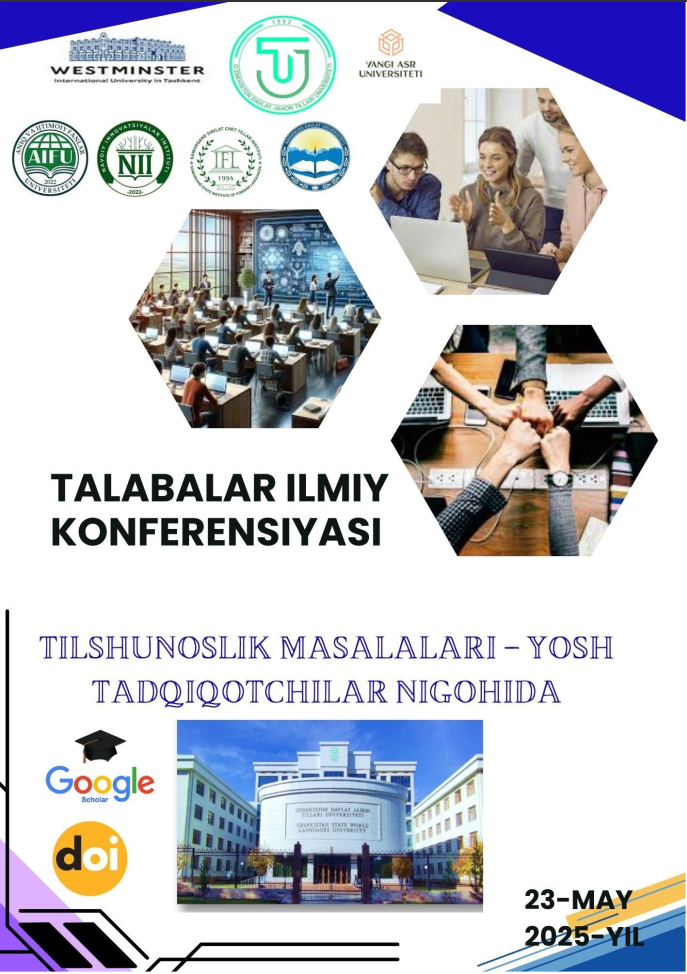SEMANTIC MAPPING OF METONYMIC TRANSFERS IN ENGLISH AND UZBEK
https://doi.org/10.5281/zenodo.15547562
Kalit so‘zlar
metonymy, semantic mapping, cognitive linguistics, metonymic transfer, English language, Uzbek language, cultural semantics, figurative language.Annotasiya
The study of metonymy, one of the most fundamental tropes in language, offers valuable insights into the mechanisms of meaning construction in both English and Uzbek. This article presents a semantic mapping of metonymic transfers in the two languages, analyzing how metonymy functions as a cognitive tool that shapes the meaning of concepts through associative relationships. By examining various examples from literature, media, and everyday speech, the research identifies common metonymic patterns and contrasts them with the cultural and linguistic systems of both English and Uzbek. The paper highlights the role of metonymy in reflecting cultural values, social contexts, and cognitive frameworks, as well as its contribution to the formation of figurative language. The comparative analysis reveals the intricacies of how metonymic processes are encoded in the lexicon of each language, considering differences in structure, usage, and cultural significance. Ultimately, this study offers a deeper understanding of the ways in which language reflects thought and culture through the subtle yet powerful mechanism of metonymy, providing a foundation for further research in cognitive linguistics and cross-cultural studies.
Foydalanilgan adabiyotlar ro‘yhati
Barcelona, A. (2000). Metaphor and Metonymy at the Crossroads: A Cognitive Perspective. Mouton de Gruyter.
Boers, F. (2003). "Applied Linguistics Perspectives on Metonymy." Annual Review of Cognitive Linguistics, 1(1), 115–132.
Buranova, D. D. (2010). O‘zbek tilida metafora va metonimiyaning lingvistik xususiyatlari. Toshkent: Fan.
Erdanova, Z. (2021). THE PROBLEM OF THE NORMS OF PHRASEOLOGICAL UNITS. Mental Enlightenment Scientific-Methodological Journal, 2021(1), 74-81.
Gulomova, R. (2022). AUTHENTIC MATERIALS AS A SOCIOLINGUISTIC APPROACH. British View, 7(1).
Kövecses, Z. (2010). Metaphor: A Practical Introduction (2nd ed.). Oxford University Press.
Musayeva, Z. A. (2019). “Comparison of English and Uzbek metonymic expressions in media texts.” Philological Sciences. Questions of Theory and Practice, 12(102), 111–115.
Naciscione, A. (2010). Stylistic Use of Phraseological Units in Discourse. John Benjamins Publishing.
Rashidova, G. (2023). INGLIZ TILI DARSLARIDA YOZISH KO’NIKMASINI O’RGATISH JARAYONIDA ZAMONAVIY INNOVATSION TEXNOLOGIYALARDAN FOYDALANISH. Engineering problems and innovations.
Sultonova, M. (2024, October). Features of Critical Thinking Skills for B1 Level Learners. In Conference Proceedings: Fostering Your Research Spirit (pp. 786-790).
Uspensky, V. A. (1995). The Semiotics of Language and Culture. Moscow: Nauka.
Yo‘ldoshev, A. (2007). Hozirgi o‘zbek adabiy tili. Toshkent: O‘zbekiston Milliy Ensiklopediyasi.

